To date, electric vehicles have cost considerably more than their gasoline-powered counterparts, but that’s finally changing. Every year, more and more inexpensive EVs are hitting the market and, with the help of local, state, and federal tax credits and rebates (if available), many of them now sell for well below the 2023 median car price of $48,000.
If you’re a budget-conscious buyer, that number is probably little consolation. However, there are a lot of good options for closer to $30,000 and below — if you know where to look. That’s why we’ve put together this guide. Here’s a list of the nine most affordable electric vehicles available right now, ranked from cheapest to most expensive. Note that we’re only including vehicles that are available in the U.S.
If these models are still too much for your budget, keep in mind that used EVs are eligible for rebates, too! And buying one of the best used EVs means you can pick a time-tested model that holds up.
2023 Chevrolet Bolt EV
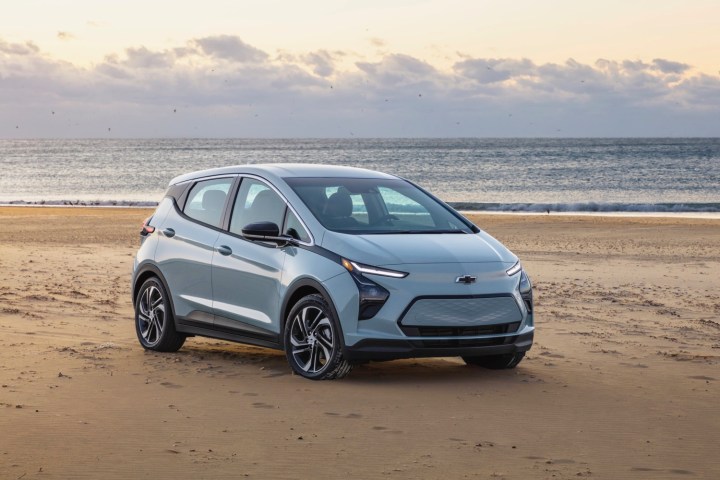
How much does it cost? $27,495 (1LT), $30,695 (2LT)
What is the driving range? 259 miles
Chevrolet’s Bolt is one of the oldest models on the list, and it’s actually on its final run after the company announced that it would be discontinuing the car after the 2023 model year. Don’t let its age fool you though — the car has a range longer than many of the other models on this list. It also comes with a long list of tech features, including a 10.2-inch touchscreen and an 8.0-inch digital instrument cluster. The 65-kilowatt-hour battery pack sends electricity to a 200-horsepower motor.
Standard tech and driver-assistance features: 10.2-inch touchscreen, Apple CarPlay, Android Auto, SiriusXM, 8.0-inch digital instrument cluster screen, automatic emergency braking, front pedestrian braking, lane keep assist with lane departure warning, forward collision alert, following distance indicator, auto high beams, rearview camera.
Available tech and driver-assistance features: Bose audio system, two additional USB ports, wireless phone charger, forward collision alert, rear-cross traffic alert, rear parking sensors, surround-view camera system, adaptive cruise control.
2023 Nissan Leaf S
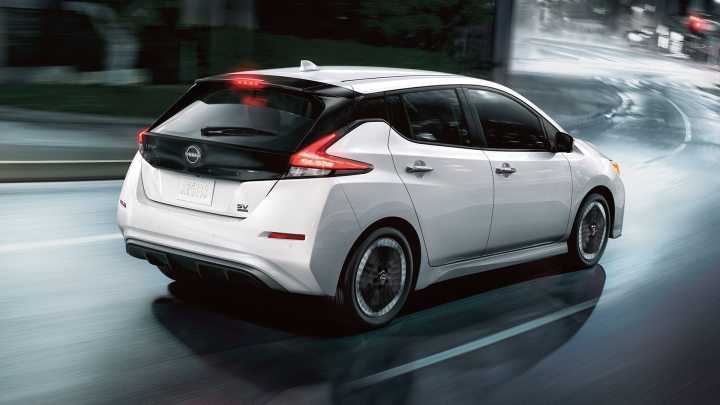
How much does it cost? $28,040 (S), $36,040 (SV Plus)
What is the driving range? 149 miles (S), 215 miles (SV Plus)
The Nissan Leaf has long been one of the cheapest electric cars, and that continues to this day. But you’ll pay for it in range. The base model only goes 149 miles, and even if you opt for the more expensive SV Plus model, its 215 miles of range isn’t amazing in 2023. Regardless of the model you pick, you’ll get equipment like rear automatic braking and a USB-C port. You can also opt for ProPilot Assist, Nissan’s advanced driver-assistance system that can steer, brake, and accelerate for drivers under certain conditions. The base model comes with a 40kWh battery pack and a 147-hp motor, while the SV Plus gets a 62kWh battery pack and a 214-hp motor.
Standard tech and driver-assistance features: 8.0-inch touchscreen, Apple CarPlay, Android Auto, 7.0-inch digital instrument cluster screen, SiriusXM satellite radio, forward collision alert, emergency automatic front braking with pedestrian detection, emergency automatic rear braking, lane departure warning, lane keep assist, blind-spot monitoring, rear-cross traffic alert, high beam assist, traffic sign recognition, rear parking sensors, DC fast charging.
Available tech and driver-assistance features: Advanced driver-assist system (ProPilot Assist), Bose audio system, adaptive cruise control, driver attention warning, surround-view camera system.
2023 Chevrolet Bolt EUV LT
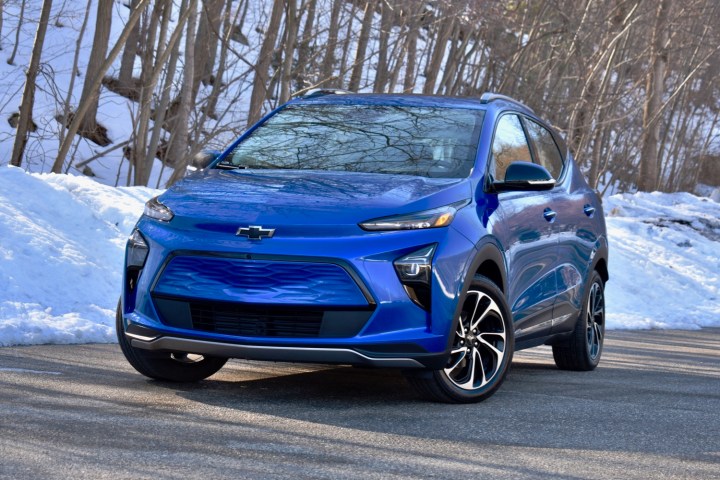
How much does it cost? $28,795 (LT), $29,290 (LT Redline), $33,295 (Premier), $33,790 (Premier Redline)
What is the driving range? 247 miles
If you like the idea of a Bolt EV, but want something a little larger, then the Bolt EUV is worth considering. The Bolt EUV is far from a full-size SUV, but it does offer a little more space than its little brother, perhaps making it a better choice for a family. The Bolt EUV comes with many of the same tech features as the standard Bolt EV, which is good news for those who want something with solid tech for the price.
Standard tech and driver-assistance features: 10.2-inch touchscreen, Apple CarPlay, Android Auto, SiriusXM, 8.0-inch digital instrument cluster screen, automatic emergency braking, front pedestrian braking, lane keep assist with lane departure warning, forward collision alert, following distance indicator, auto high beams, rearview camera.
Available tech and driver-assistance features: Bose audio system, two additional USB ports, wireless phone charger, forward collision alert, rear-cross traffic alert, rear parking sensors, surround-view camera system, adaptive cruise control.
2023 Mini Cooper Electric

How much does it cost? $30,900
What is the driving range? 114 miles
The Mini Cooper has a long history to it, but if you’re interested in an EV version, you’ll have to deal with a pretty short range. The Mini Cooper SE has a range of a measly 114 miles, which means it’s probably only a good option for those who want to drive around town and can charge at home. The 28.9kWh battery pack zaps a 181-hp electric motor. Tech features are ample (with the exception of Android Auto, which is missing), but the SE lacks some driver-assistance features, including adaptive cruise control. If you don’t drive far or have another car with more range, this cool little EV could be right for you.
Standard tech and driver-assistance features: 8.8-inch touchscreen, Apple CarPlay, 5.5-inch digital instrument cluster screen, forward collision alert, emergency automatic front braking, DC fast-charging capability.
Available tech and driver-assistance features: Harman Kardon audio system, wireless phone charger, head-up display, self-parking system.
2023 Hyundai Kona Electric
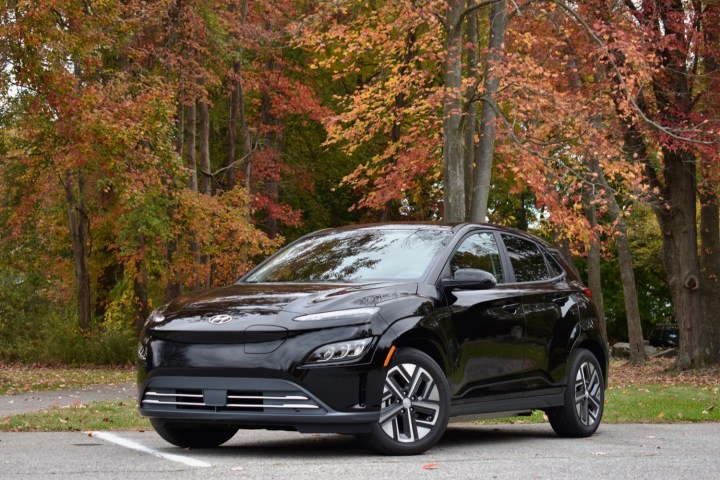
How much does it cost? $33,550 (SE), $37,300 (SEL), $41,550 (Limited)
What is the driving range? 258 miles
The Hyundai Kona Electric rides on the same platform as the Kia Niro EV, and it uses the same basic drivetrain. It puts 201 hp under the driver’s right foot, but its driving range is slightly higher than its Kia-badged sibling. It offers a comprehensive list of standard and optional equipment, but its starting price has crept up. If you want all of the bells and whistles, the top Limited trim offers features like a head-up display, but it starts at a higher price than the other models.
Standard tech and driver-assistance features: 8.0-inch touchscreen, Apple CarPlay, Android Auto, 10.25-inch digital instrument cluster screen, SiriusXM satellite radio, forward collision alert, emergency automatic front braking, lane departure warning, lane keep assist, blind-spot monitoring, rear-cross traffic alert, driver attention warning, DC fast-charging capability.
Available tech and driver-assistance features: 10.25-inch touchscreen, Harman Kardon audio system, head-up display, wireless phone charger, adaptive cruise control.
2023 Mazda MX-30
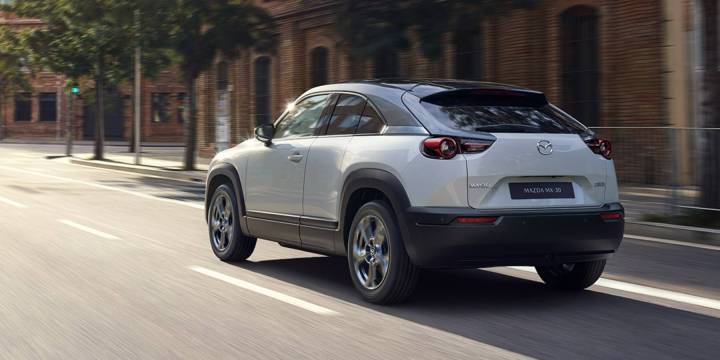
How much does it cost? $34,110
What is the driving range? 100 miles
Here’s another car with some cool features, but an extremely limited range. The 2023 Mazda MX-30 may be bigger than a car like the Mini Cooper Electric, but it has a lower range — only 100 miles. That makes it a poor choice if you want an EV you can take on trips. Still, if you are fine with a very limited range, you’ll get things like a relatively stylish design and the satisfaction of eco-friendly interior materials.
Standard tech and driver-assistance features: Adaptive front-lighting system, Apple CarPlay, Android Auto, two USB audio inputs, 8.8-inch touch display, 7.0-inch digital instrument cluster, rear view camera.
Available tech and driver-assistance features: Bose audio system, blind spot assistant, SiriusXM Satellite Radio.
2023 Volkswagen ID.4 Standard
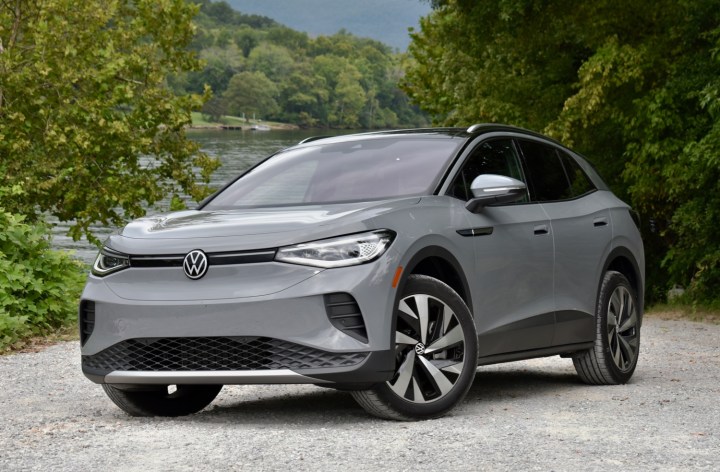
How much does it cost? $38,995 (Standard), $43,995 (Pro), $47,795 (AWD Pro), $43,995 (S), $48,995 (Pro S), $52,795 (AWD Pro S), $51,445 (Pro S Plus), $55,245 (AWD Pro S Plus
What is the driving range? 209 to 275 miles
Finally, we’re back to EVs with a halfway decent range. The ID.4 has long been one of the more popular EV options, and within the ID.4 range, there are a ton of trims to choose from. These trims offer radically varied features and ranges, so no matter what kind of tech you want, it’s likely that there’s something for you. Even the base model, however, isn’t bad, with a range of 209 miles and a single rear motor that can deliver 201 hp.
Standard tech and driver-assistance features: 12-inch touchscreen, wireless charging, advanced driver assistance (IQ.DRIVE), rearview camera, blind spot monitoring with rear traffic alert, forward collision warning, automatic emergency braking, light assistant, SiriusXM,
Available tech and driver-assistance features: 360-degree view, power liftgate, three-zone climate control.
Tesla Model 3
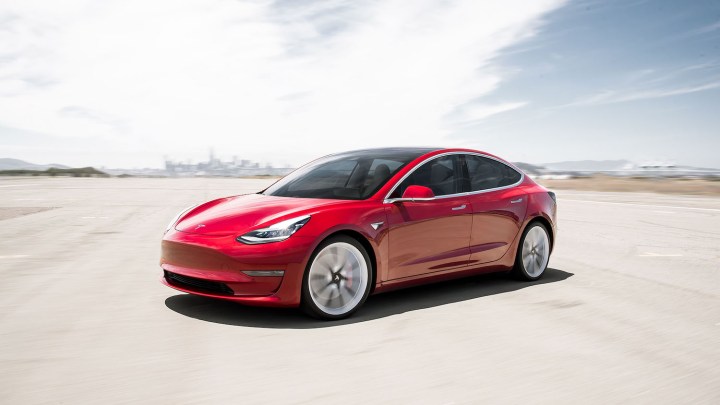
How much does it cost? $40,240 (Standard), $47,240 (Long Range), $53,240 (Performance)
What is the driving range? 272 to 333 miles
The Model 3 offers longer range than any other car on this list, even in the base model. While it’s also one of the most expensive cars on this list, it’s Tesla’s cheapest model. You get all the tech you would expect from Tesla, like a massive touchscreen and the option for Autopilot, plus tech you don’t expect, like Dog Mode and in-car arcade games. And don’t forget the company’s impressive Supercharger network, which is a huge leg up on road trips.
Standard tech and driver-assistance features: 15-inch touchscreen, four USB ports, two smartphone docks, Bluetooth media streaming, and Autopilot (including lane keep assist, adaptive cruise control, collision warning, automatic braking, and blind-spot monitoring).
Available tech and driver-assistance features: Satellite maps with live traffic, in-car internet, video streaming, Caraoke, Full Self-Driving Capability (including automatic lane changes, Summon, Traffic Light and Stop Sign control, plus Autopark). Note that Premium Connectivity requires a monthly subscription.
2023 Kia Niro EV

How much will it cost? $39,550 (Wind), $44,550 (Wave)
What is the driving range? 253 miles
Like other Kia electric cars, the Kia Niro EV offers good range, 201 hp, and plenty of standard and available features. The main difference is the price; this EV starts at almost $40,000, mostly because it comes standard with more equipment and a more stylish design. The top trim takes the price to almost $45,000, which is only a little cheaper than the Model 3 Long Range. However, the majority of driver-assistance features offered come standard.
Standard tech and driver-assist features: 10.25-inch touchscreen, Apple CarPlay, Android Auto, 10.25-inch digital instrument cluster screen, SiriusXM satellite radio, adaptive cruise control, forward collision alert, emergency automatic front braking with pedestrian detection, lane centering, lane departure warning, lane keep assist, blind-spot monitoring, rear-cross traffic alert, driver attention warning, and DC fast-charging capability
Available tech and driver-assist features: 10.25-inch touchscreen, Harman Kardon audio system, wireless phone charger, rear parking sensors, highway driving assist.
Editors' Recommendations
- Cybertruck production reportedly halted over pedal issue
- Tech giant reveals nice price for new EV to take on Tesla
- Tesla faces new rival as a tech giant launches its first EV
- Porsche’s most powerful production car is an EV
- The R3 is Rivian’s surprise electric crossover


